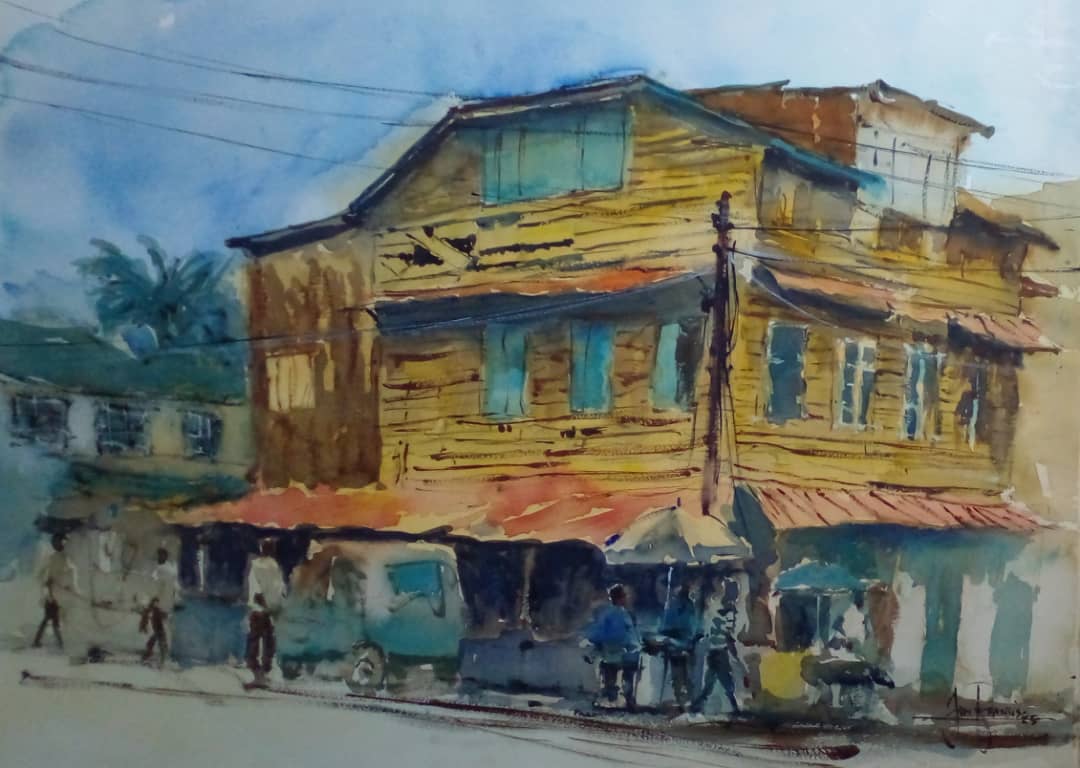So You Bought Art… Now What? A Conversation with Myrtha Steiner
We first met Swiss artist and curator Myrtha Steiner during Art Basel Week. The conversation lingered, and a few weeks later, we found ourselves in a cross-country virtual meeting — Switzerland, France, Sierra Leone — with Myrtha on one end, us at unx-art on the other, asking her the kinds of questions that every collector thinks about but rarely says out loud. What makes a collector? How do you keep an artwork safe at home? What paperwork is worth keeping? This blog is the result of that conversation — a witty guide, but also a serious one, built on decades of Myrtha’s experience managing collections around the world.
What Makes a Collector?

©Bruce Onobrakpeya, Three Fly Whisks "Igbudia Erha"
Imagine strolling through an unx-art exhibition. You see a piece you love — the colour clings to your mind, the story won’t let you go. That’s how it begins: instinct, whim, curiosity. But what makes a collector isn’t the number of works on the wall, it’s the thread that eventually binds them together.
“But a buyer becomes a collector when those whims begin to connect. A thread emerges. A direction. A concept that says: this is not just taste; this is a collection.”
Myrtha explained that most people start by buying what they like, without thinking further. Over time, when houses fill up or friends ask, “What exactly are you buying?”, a shift occurs. Collectors begin to see patterns: perhaps an interest in contemporary African voices, women artists, abstraction, or works tied to a specific decade. Once there’s a guiding idea, collecting stops being a mere accumulation and becomes a practice.
Documentation & Due Diligence
“Paperwork: Keep Everything.”
Impulse alone doesn’t secure legacy. The backbone of a collection is documentation: certificates of authenticity, invoices, provenance, and shipping records. Without them, a painting is just paint on canvas; with them, it is a cultural marker with a story that can travel.
Sor Sen, "Soakin it in All III" at The Matter of Now, unx-art exhibition.
At unx-art, every artwork is accompanied by a certificate of authenticity signed by both the artist and curator, together with a formal invoice — the cornerstone of any collection’s provenance.
Being based in Africa, we work directly with the artists where they create. We visit their studios, understand their process, and build enduring relationships. This first-hand connection means every piece we present is genuine, traceable, and anchored in trust.
“Trust is important, but records are essential.”
Myrtha was unequivocal: pay traceably, avoid cash, and store records carefully. Today’s impulse buy may, decades from now, be the cultural artefact your heirs inherit — and their ability to prove ownership will depend entirely on your diligence.
Caring for Art at Homes
"Every Material Will Age",
Chike Emembo, "The Rise & Fall of Man", 2023
Collectors are not just buyers; they are caretakers. Art is alive to its environment: light fades pigment, humidity feeds mould, and cleaning — especially enthusiastic cleaning — can be an unexpected enemy.
“Think of your grandmother’s teapot. You don’t put it in the dishwasher. You handle it with care, because you cherish it.”
Myrtha reminded us that even small choices make a difference. Two nails are better than one so a painting doesn’t tilt. Watercolours should be framed with UV-filtered glass. Sculptures need stable bases away from hallways where backpacks swing. And please — never hang a canvas in a bathroom unless it’s impervious to steam.

Sor Sen, "Soakin it in All II" 2023
As she put it with a laugh: “The vacuum cleaner is insurance companies’ nightmare.” A well-meaning sweep can topple a frame faster than sunlight can fade it.
Storing Without a Professional Facility
Not every collector has access to climate-controlled vaults. Many will rely on a room at home. This is no tragedy — common sense goes a long way. Choose a dark, clean, stable space. Avoid attics with wild temperature swings and basements prone to mould. Keep work off the floor using pallets, and leave space between them so they can breathe.
Kon-T, "Connection", 2020
Ventilation, even a simple fan, helps in rainy seasons. When moving artworks, pack as if you anticipate impact: breathable wrapping, cushioned corners, and softening for jolts in vehicles. Transport is often riskier than storage — but careful packing makes survival likely.
Common Mistakes New Collectors Make
Carelessness, not malice, is the most common threat. Paintings crammed together in storage so they “sweat.” Sculptures left in busy hallways. Frames touched by cleaning products. Or worse — buyers forgetting that ageing is natural. A crack after twenty years may not be a catastrophe, but it is chemistry.
Olasunkanmi Oyelusi, "Sisters Love", 2025
Collectors sometimes overprotect too, covering canvases with expensive museum glass without spacing — creating microclimates that cause more harm than good. The balance lies in restraint and attention.
When to Call a Professional

Even the most attentive collector will meet their limits. Restoration, complex installations, international shipping, or questions of authenticity are moments when professional help is not indulgence but necessity. It may feel costly, but as Myrtha put it, professional involvement often saves far more money (and heartbreak) in the long term.
Collecting as a Relationship
The Matter of Now, unx-art Exhibition, 2025, The Tour
In the end, collecting is less about ownership than about dialogue. Every piece has a temperament, a quirk, a demand. To collect is to pay attention, to stay curious. At unx-art, we see collecting as an ongoing conversation — between you, the artist, and the generations to come.
“Art collecting is a relationship — it grows richer with care, curiosity, and common sense.”
A collection isn’t just a fixed display; it is a living exchange. Instinct sparks the first encounter, but trust, care, and discipline sustain the legacy. When each piece is understood as part of this dialogue, a collection becomes more than an archive — it becomes a legacy of conversations carried forward.
Helen Nzete, "V is for Energy", 2019, The Matter of Now, unx-art Exhibition.
Discover our collection at unx-art.net. Reach out on Instagram, Facebook, or WhatsApp — and explore our previous editorials on collecting.
About Myrtha Steiner
Myrtha Steiner (b. 1962, Zug, Switzerland) is a Swiss artist and curator. Educated in Zurich, Milan, and Budapest, she has exhibited widely and curated for major collections including the Hess Art Collection and SKKG. Through her “Curator on Demand” service, she guides private collectors in preservation, documentation, and collection strategy. Learn more at myrthasteiner.com and Curator-on-demand.com.
Disclaimer
The insights shared in this editorial are intended for cultural and educational purposes only. They do not constitute tax or legal advice. Regulations on VAT, customs, and inheritance vary by jurisdiction; for specific guidance, please consult the relevant authorities or professionals.









